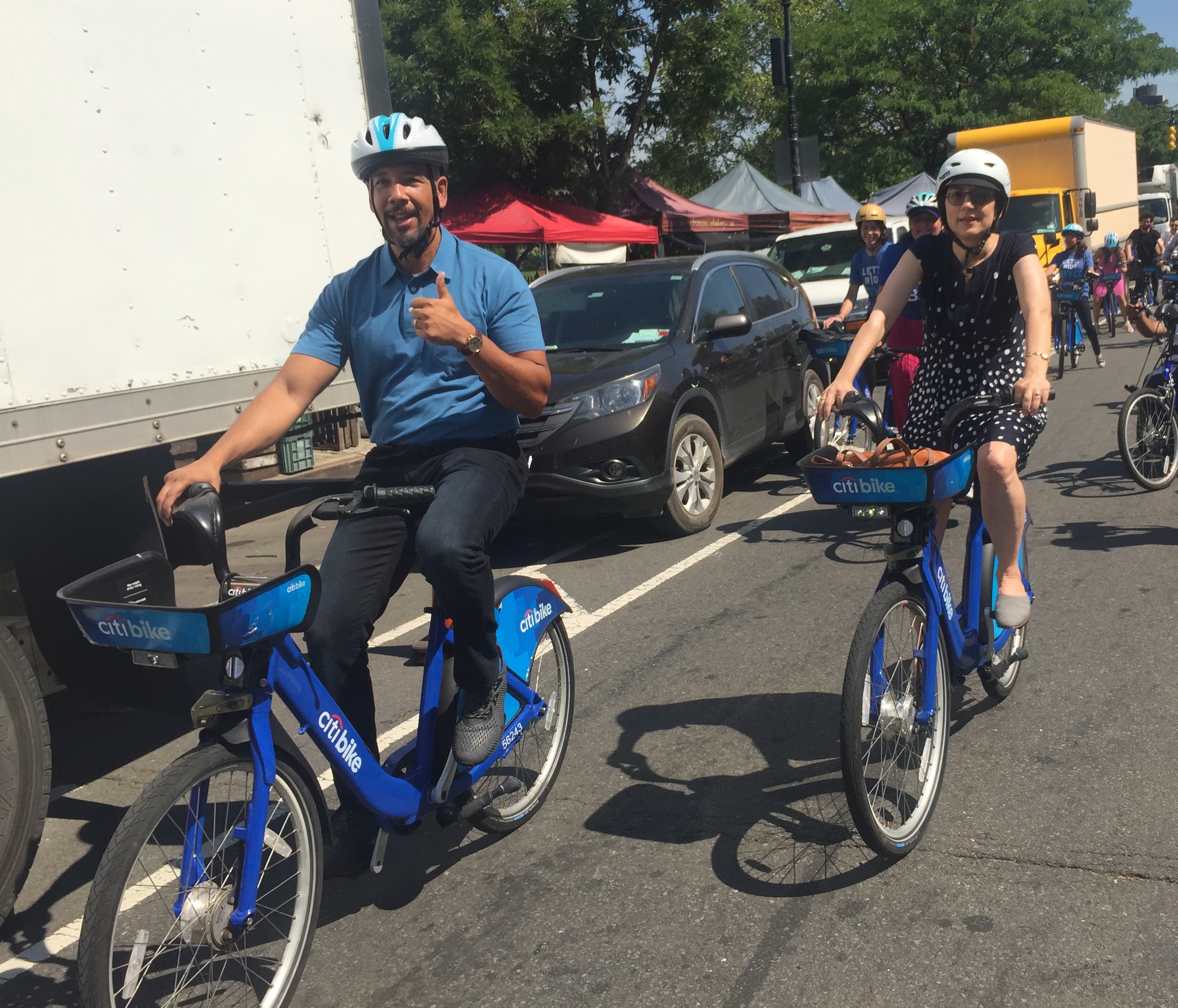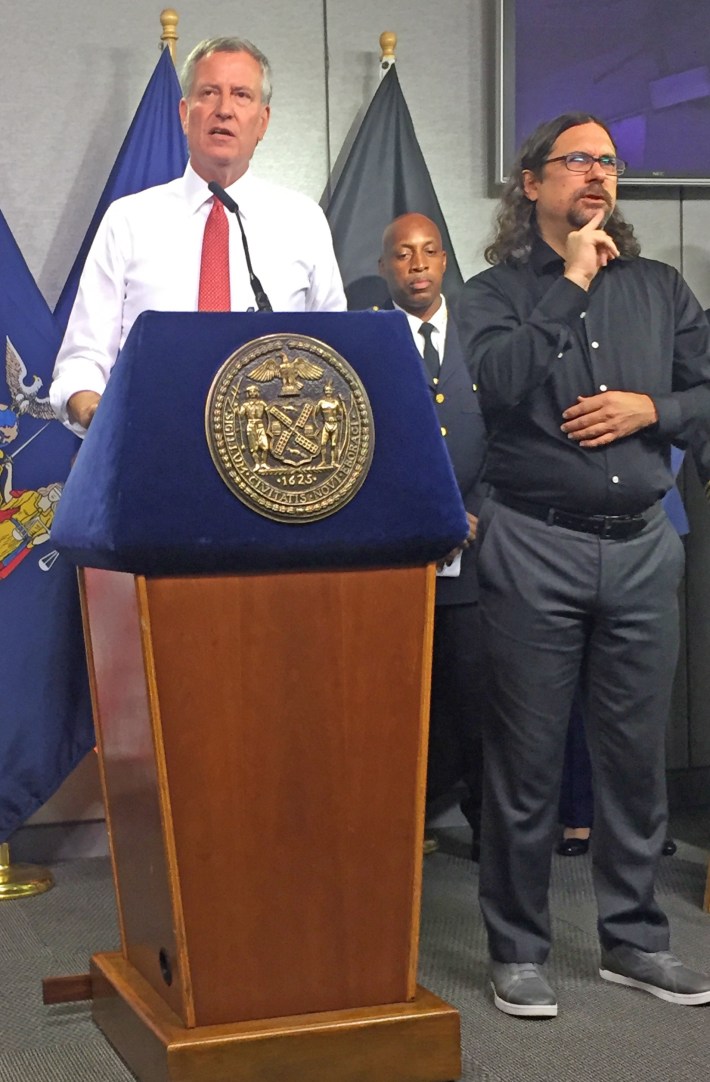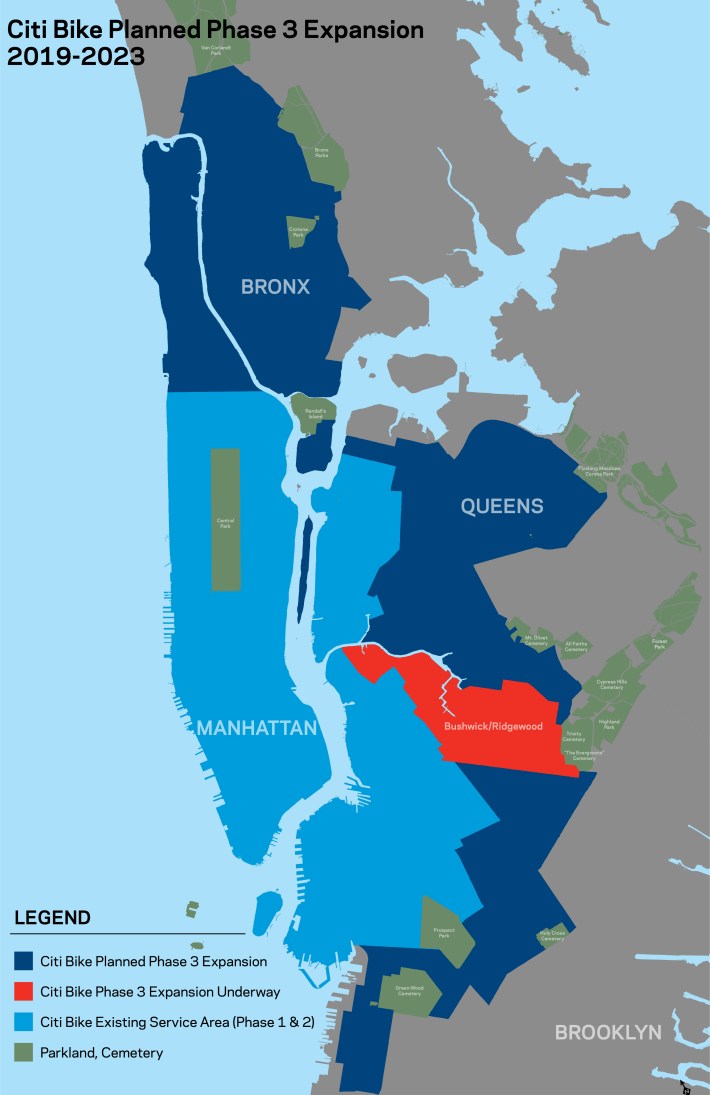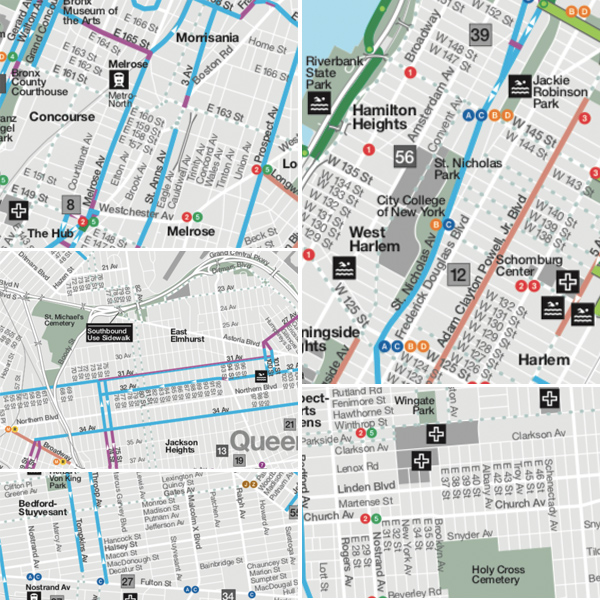Mayor: I Want to Do Citi Bike on the Cheap (And I’ll Try to Keep Riders Safe)
3:59 PM EDT on July 17, 2019

Last year, Bronx Borough President Ruben Diaz Jr. and DOT Commissioner Polly Trottenberg rode Citi Bikes to herald a coming expansion. Well, planning is finally underway. Photo: Gersh Kuntzman
Mayor de Blasio confirmed on Wednesday why the just-announced expansion of Citi Bike — one of the city's most successful and popular forms of public transportation — will take four years to reach only a tiny fraction of the city: He doesn't want to pay for it.
The mayor's comments came one day after DOT Commissioner Polly Trottenberg said the slow rollout stemmed from the fact that she only has a team of 12 community outreach workers for the siting of new Citi Bike docking stations — and that only a city investment of $400-$500 million, partly from taxpayers, could create a truly citywide Citi Bike system.

The mayor said he won't beef up Trottenberg's team — nor will he invest public money into this public transit mode as he has done for his own ferry system, which has cost more than $600 million. Citi Bike is that rarest of forms of mass transit: It gets no public subsidy. In fact, the Lyft-owned Citi Bike pays the city for the parking spaces its docks occupy — in a sense, forcing public transit to subsidize taxpayers, rather than the other way around.
"It's a great question," de Blasio started after Streetsblog raised the issue on Wednesday. He then explained why he doesn't want to pay for a form of transit that could benefit everyone:
One, we've had a situation where we weren't required to invest city money and our goal is to not invest city money where we don't have to. ... We have something that has been a great success and has not required city money, honestly, it is not my impulse to say, "Let's start putting city money in that." ... I would say to you that there is no way, in my opinion, to start a true citywide waterborne transit system without the city taking the lead. ... I believe when you come back in 10 years, people will say actually that was a smart thing because [the ferry system] became a much greater part of our transit system. ... So the answer is, fair question, but I stand very comfortably by the notion that certainly up to now not subsidizing it has still allowed us to get the result we needed.
Streetsblog followed up about the parking fees, but the mayor doubled-down: "Again, what we have seen to date is a system that has steadily expanded and not cost the taxpayer money. That's ideal."
He added he would "certainly look" at putting some public money into Citi Bike in the future — but this level of mayoral initiative will need more than just a casual glance, but a substantial lift. And this mayor has weak arms for that particular dumbbell: "I do want to emphasize the appeal of Citi Bike is that it did not expose the city financially."
The mayor could seek support from several elected officials who would be open to bailing him out with public money. Council Member Ydanis Rodriguez, who chairs the council's Transportation Committee, has called for a greater public investment in Citi Bike to ensure that the expansion truly meets the needs of the less fortunate. He said on Tuesday that Citi Bike should be eligible for the city's "Fair Fares" MTA discount program. Currently, NYCHA residents can get Citi Bike memberships for just $60 per year, but only 3,000 people are taking advantage of it. Rodriguez — and other critics — want more.
"I will keep working to expand this program to any community, especially those in transportation deserts," Rodriguez said.
State Senator Jessica Ramos of Queens also thinks its bizarre that a form of public transportation with roughly 80,000 trips per day is entirely financed by a private, profit-making company.
"I am highly skeptical of corporations in general, and public-private partnerships lend are best used for pilot programs," she said on Tuesday. "Ultimately, I believe in overall equity and the civilians' responsibility to each other."
Of course, other representatives of other neighborhoods aren't so sure public money should be devoted to a system that currently only covers Manhattan below 131st Street and small slivers of Brooklyn and Queens.
"No subsidy," said Bronx Borough President Ruben Diaz, a strong believer in Citi Bike who nonetheless wants Lyft to pay for the expansion and the greater equity it will likely bring. "Not until we have [Citi Bike] in the Bronx first."
And when will that be, exactly? Not before 2020 — and only in part of The Bronx and Upper Manhattan. Trottenberg's team said the first phase of the 2019-2023 expansion would start this fall with "six to nine months" of community outreach in the South Bronx and Manhattan — even though the expansion zone map covers far more territory.
The problem? Trottenberg's "team" is small. Not that there's anything wrong with that, she claims.
"We are as going as quickly as we can possibly can," Trottenberg said on Tuesday. "We have a team of about 12 people. I have tasked the team with doing this as fast as it possibly can. I would love to be doing work in all four boroughs if possible."

If she would, indeed, love it, she hasn't successfully communicated that to the mayor.
And it is unclear if she has forcefully argued for the $400- to $500-million investment that the city and Lyft could make right now to bring Citi Bike to the entire city. In fact, Trottenberg heralded the 2019-2023 expansion as one that would raise New York City's bike-share system from eighth-largest in the world to "the second- or third-biggest in the world," she said. (Funny, but "We're number 2! We're number 2!" is not something most sports fans would enjoy chanting.)
Even beyond the pace or area of expansion, Citi Bike is plagued by the greatest challenge of the de Blasio administration: keeping Citi Bike riders safe. Fifteen cyclists have been killed this year, up from 10 all of last year, and the mayor has charged Trottenberg with creating a new "bicycle safety plan" that is expected to be released next week.
But there's no magic wand — there's a stronger commitment to building out the bike network with protected, not mere painted, lanes. But here the mayor is inconsistent: In 2017, the DOT identified 10 community boards as "priority bicycle districts," meaning that all 10 would get special attention from the city. In eight of the districts, cyclist injuries have actually gone up, as Dave Colon reported in Streetsblog this week.
Awkward.
De Blasio promised more Vision Zero efforts, and more enforcement against reckless drivers. And Trottenberg also said that Citi Bike and better bike infrastructure go hand in hand.
"It's no secret this has not been a good year for us," she said, referring obliquely to the Colon report. "But as we expand Citi Bike, it dovetails very nicely with areas where we are going to focus our infrastructure efforts." She continued:
When you look at this map, it dovetails nicely with what we announced would be our cycling priority areas. ... We are seeing cycling increase in those areas, but we know we need more cycling infrastructure to make sure that it's safe. And we found that, for example, in Brooklyn, on Fourth Avenue. That redesign project did not originally have a protected bike lane, but as Citi Bike came to Park slope and it became obvious that it would eventually continue to Sunset Park, it was clear that this kind of a major corridor needed protected bike infrastructure and we got consensus on that pretty quickly. It's a fair challenge for us ... but have to make sure as we build out the system, we have to build that infrastructure. But we also find that as we build out the system, it also creates a lot of support for that infrastructure.
That's also a slow process, Streetsblog told Trottenberg, citing massive holes in the current infrastructure even before next year's beginning of the slow Citi Bike rollout: Bike paths on the Queensboro and Brooklyn bridges are already overcrowded; the city removed a protected bike lane on Dyckman Street almost a year ago at the behest of some local pols and has not yet restored it; the First and Second avenue protected bike lanes are so crowded that at any given time, there are more humans crammed into a seven-foot-wide bike lane than there are in all the cars on the rest of the 60-foot-wide street; and there are countless streets that could simply be closed to cars to create safe routes for cyclists.
And it doesn't take Rand McNally to see that the 2019-2023 expansion map is heading Citi Bike into neighborhoods with not a single protected bike lane on a street (photo montage below). That's cause for alarm, said Tom DeVito, senior director of advocacy for Transportation Alternatives.

"I was a very young organizer when Citi Bike launched and I remember there was no consensus that this was a program that was going to work," he said. "But we knew that if you provide people with an affordable, safe way to get around, with bikes, people will do it. Citi Bike lowered the bar of entry for a form of transportation that is reliable and green — and ultimately we need to be doing more to foster it. ... Our fight is not over. We need to make sure that safe bike infrastructure is expanding along with it. Bike share and protected bike lanes must go hand in hand for this system to be successful."
Gersh Kuntzman is editor in chief of Streetsblog NYC and Streetsblog USA. He also writes the Cycle of Rage column, which is archived here.
Read More:
Stay in touch
Sign up for our free newsletter
More from Streetsblog New York City
Thursday’s Headlines: Speed-Limiting Tech Edition
State Sen. Andrew Gounardes continues his push to force reckless drivers to install speed limiters in their cars. Plus more news.
DOT Official: All Our Free Parking Justifies Keeping Curb Space for EVs
If only someone could do something about the parking!
New York City to Install 500 Secure Bike Parking Hubs In The Next Five Years: Sources
Your bike may finally get a roof over its head.
Adams Backs Lower Speed Limits, Calls Crashes ‘Accidents’
The mayor wants New York City drivers to "slow down," but it's not clear yet how many streets will get lower speed limits.
Wednesday’s Headlines: Trump Posts About Congestion Pricing Edition
Donald Trump comments on congestion pricing — no surprise, he's against it. Plus more news.




